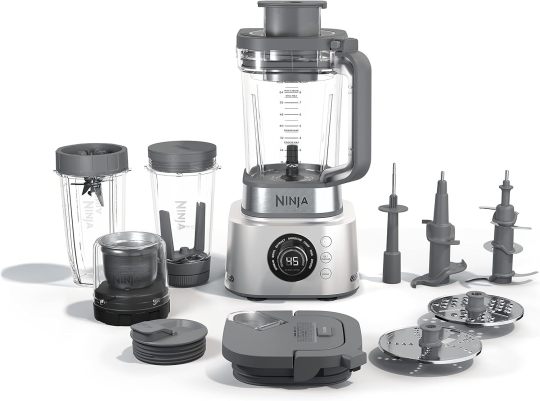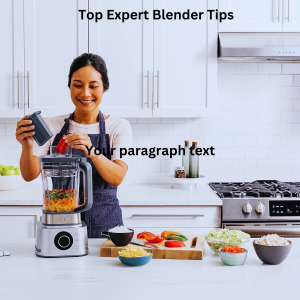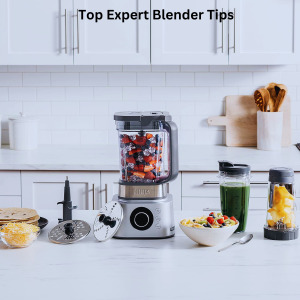#blendersecrets
Explore tagged Tumblr posts
Text
Top Expert Blender Tips to Help You Make Perfect Juice Every Time

Introduction
Juicing can be a delicious and refreshing way to get your daily intake of fruits and vegetables, but achieving the perfect juice can sometimes feel like a science experiment gone wrong. However, with the right tips, tricks, and tools, you can make juice that’s not only flavorful but packed with nutrients every single time. Whether you’re just starting your juicing journey or looking to elevate your skills, these expert blender tips will help you create the perfect juice consistently. top Expert blender tips
Choosing the Right Blender for the Job
High-Powered Blenders vs. Standard Blenders
The type of blender you use can have a significant impact on the quality of your juice. High-powered blenders, like Vitamix or Blendtec, are designed to pulverize fruits and vegetables into ultra-smooth juice. These blenders handle tougher ingredients like leafy greens and fibrous veggies with ease.
Benefits of High-Powered Blenders
High-powered blenders ensure that no chunks are left behind. They also extract more nutrients, as they break down cell walls more effectively, giving you a smoother, creamier juice. This makes them perfect for those who want to get the most out of their produce. top Expert blender tips
Can You Use Standard Blenders for Juicing?
While standard blenders may not be as powerful, they can still make decent juice, especially when combined with proper ingredient preparation. You may need to blend a bit longer or strain your juice for a smoother texture, but they get the job done if you’re not ready to invest in a high-powered model.
Important Qualities to Consider in a Juicer Blender
Power and Speed Settings

Blade Quality and Design
Look for blenders with strong, durable blades made from stainless steel. Blades designed with multiple angles can better reach all parts of the jar and ensure consistent blending.
Ease of Cleaning
Juicing can be messy, so choosing a blender that’s easy to clean is crucial. Look for models with dishwasher-safe parts or those that are easy to disassemble for quick cleaning.
Preparing Your Ingredients for the Best Juice
Choosing Fresh, Organic Produce
Fresh, organic ingredients are the foundation of great juice. Organic fruits and vegetables not only taste better but also provide more nutrients and are free of pesticides. Whenever possible, opt for seasonal produce to ensure maximum flavor.
The Importance of Fresh Ingredients top Expert blender tips
Using fresh produce ensures that your juice is packed with vitamins and minerals. Overripe or old ingredients may give your juice a dull flavor and reduce its nutritional value.
Cutting and Prepping for Optimal Blending top Expert blender tips
Before tossing your fruits and veggies into the blender, cut them into smaller pieces. This helps your blender work more efficiently and reduces strain on the motor. Harder ingredients like carrots or beets should be sliced thinly for better blending.
Should You Peel or Leave the Skin On? top Expert blender tips

Mastering the Blending Process
Using the Correct Blending Speed
Different ingredients require different blending speeds. Softer fruits like bananas or berries may only need a low speed, while harder vegetables like carrots or beets may require a higher speed.
Low Speed vs. High Speed top Expert blender tips
Using the correct speed is essential to ensure smooth blending. Starting on a lower speed and gradually increasing to a higher speed can help prevent splattering and ensure all ingredients are evenly blended.
Blending Techniques for Smooth Juices
Pulsing vs. Continuous Blending
Pulsing your blender can help break down tough ingredients without over-processing them. Continuous blending, on the other hand, is great for achieving an ultra-smooth texture.
Avoiding Overheating Your Blender top Expert blender tips
Blenders can overheat, especially when processing tough ingredients for too long. To prevent this, blend in short bursts and give your blender time to cool down if you’re making a large batch of juice.
Enhancing Flavor and Nutritional Value
Adding Natural Sweeteners top Expert blender tips
To sweeten your juice naturally, try adding ingredients like honey, maple syrup, or dates. These not only enhance the flavor but also provide additional nutrients.
Including Superfoods for a Nutrient Boost
Chia Seeds, Flaxseeds, and Spirulina
Adding superfoods like chia seeds, flaxseeds, or spirulina can boost the nutritional profile of your juice. These ingredients are packed with omega-3s, fiber, and antioxidants, turning your juice into a nutrient powerhouse.
Balancing Fruits and Vegetables
Achieving the perfect balance between fruits and vegetables is key to making a juice that’s both delicious and nutritious. Too many fruits can make your juice overly sweet, while too many vegetables may result in a bitter taste. Experiment with different ratios to find your ideal balance. top Expert blender tips
Troubleshooting Common Juicing Issues
How to Avoid Frothy Juice
If your juice turns out frothy, try blending at a lower speed or letting the juice sit for a few minutes before serving. You can also strain it using a fine-mesh sieve or cheesecloth to remove excess foam.
Fixing Gritty or Chunky Juices
If your juice is too gritty or chunky, it could mean that your blender isn’t powerful enough or that you need to blend for a longer time. Straining the juice can help, but investing in a more powerful blender might be the ultimate solution. top Expert blender tips
Preventing Bitter Flavors in Your Juice

Storing Juice for Maximum Freshness
Best Containers for Juice Storage
Use airtight, glass containers to store your juice. Glass helps maintain the flavor and prevents any chemicals from plastic containers from leaching into your juice.
How Long Can You Store Fresh Juice?
Fresh juice is best consumed immediately, but if you must store it, keep it in
Preventing Nutrient Loss in Stored Juice top Expert blender tips
If you’re storing juice, it’s important to minimize nutrient loss. Keep your juice in an airtight container and store it in the coldest part of your fridge. Light and heat can degrade the nutrients, so try to avoid exposing the juice to direct sunlight.
Cleaning and Maintaining Your Blender
Quick Cleaning Hacks for Your Blender
To clean your blender quickly after juicing, simply fill the jar halfway with warm water, add a drop of dish soap, and blend on high for 30 seconds. This helps dislodge any leftover pulp or residue. Rinse thoroughly with clean water, and you’re done!
Deep Cleaning for Long-Term Maintenance
For a more thorough clean, especially if you juice regularly, disassemble the blender and soak the blades, jar, and lid in warm soapy water. Use a small brush to scrub any stuck-on residue, then rinse and dry all parts before reassembling.
Best Practices for Blade Care top Expert blender tips
Taking care of your blender blades is crucial for their longevity and performance. Avoid blending hard items like ice without liquid, as this can dull the blades. Additionally, always ensure the blades are completely dry before reassembling your blender after cleaning to prevent rust.
Conclusion
Juicing at home can be a game-changer for your health and wellness journey, but getting it just right requires some knowledge and practice. With these expert blender tips, you’re well on your way to making perfect juice every time—smooth, flavorful, and nutrient-rich. From choosing the right blender to mastering the blending process, and from troubleshooting common issues to ensuring proper storage, you now have all the tools to make juicing a breeze. So, grab your favorite fruits and veggies, fire up your blender, and enjoy the delicious benefits of fresh juice! top Expert blender tips
FAQs
1. How can I make my juice smoother?
To make your juice smoother, try using a high-powered blender and blend for a bit longer. You can also strain your juice using a fine-mesh sieve or cheesecloth to remove any remaining pulp or fibers. top Expert blender tips
2. Can I use frozen fruits in my blender? top Expert blender tips
Yes, frozen fruits can be used in a blender to make juice or smoothies. Just make sure your blender is powerful enough to handle frozen produce, and add some liquid like water, coconut water, or juice to help the blending process.
3. What are the best fruits and vegetables for juicing?
Some of the best fruits for juicing include oranges, apples, pineapples, and berries. As for vegetables, carrots, cucumbers, celery, spinach, and kale are great options. You can mix and match to create your perfect blend of flavors and nutrients.
4. How do I prevent juice from separating after blending?
Juice naturally separates after blending due to the different densities of fruits and vegetables. To reduce this, blend your juice on a higher speed for longer. Adding a thickening agent like chia seeds can also help keep the juice from separating. top Expert blender tips
5. Is there a way to make my juice more filling?
To make your juice more filling, try adding healthy fats like avocado, coconut oil, or flaxseeds. These ingredients not only add nutrients but also increase the satiety level of your juice, making it more satisfying and keeping you full for longer.
#BlenderTips#PerfectJuice#JuicingHacks#HealthyBlends#JuicePerfection#ExpertBlending#SmoothJuice#BlenderSecrets#JuicingMadeEasy#HealthyJuice
0 notes
Text
Rechargeable Portable Blender 12Blades 7.4V Mini Portable Electric Mixer 1000ML Household Juicer 20% Off - https://s.click.aliexpress.com/e/_DC2AeLD
Transform Your Life With Authentic Health & Wealth Solutions (Copy/Paste Below Link) bio.link/earnpassiveincome
#Blenders#blenders#blenderset#blendershare#blenderspride#blenderstreet#blendersculpt#blendersecrets#blenderseyewear#blenderspridefashiontour#PortableBlenders#portableblenders#rechargeableblender#blender#blender3d#blenderart#blenderguru#blenderartist#blenderrender#blendercycles#blendertutorial#blenderanimation#blendercommunity#electricblender#electricblenders
1 note
·
View note
Video
instagram
Это то, что я так долго искал: одна переменная для нескольких объектов в #Blender! 🙌 #b3d #blendersecrets #blendertips #b3dtips #blendertricks https://www.instagram.com/p/CdsQBGRI31X/?igshid=NGJjMDIxMWI=
1 note
·
View note
Text
This is my go-to method to decimate all kinds of CC. It's very clean and you can exactly decide where you want to keep denser geometry and where to reduce! To make this process faster, there is a nifty way to select every other edge loop to quickly decimate the loops by 50%, which is especially useful for clothing meshes that have a tubular shape (use it on sleeves, pants, tops, shoelaces, jewelry chains...) Remember to first convert the mesh into quads using alt+j as bellakenobi mentioned or it won't work. Depending on the structure of the mesh, the loops might not get selected all the way through automatically and some manual selecting is necessary to finetune the result, but it's worth it. I don't find this method takes an unreasonable amount of time, and it gives such great and clean results that it makes working with the meshes much easier too since you do not get faces randomly deleted like with the decimate modifier. This is a helpful video tutorial that explains the technique: how to select every other edge loop!!
Once the loops are selected according to the video tutorial, you just dissolve the edges (x -> dissolve edges). Remember to also dissolve some of the edges going into the other direction (if you dissolved the vertical loops, also dissolve horizontal ones) to reduce overall density! As bellakenobi mentioned, with one or more parallel loops selected, you can double tap g to enter edge slide mode to re-adjust the remaining edge loops. This is not only very convenient and less prone to cause issues, because it just slides along the surface of the mesh, not elsewhere, but edge slide will automatically adjust the UV map for you too to reflect those changes, which means less work for you.
Tips for fixing topology: Selecting edge loops works best on quads, but there are several ways that you can edit and alter a face. for example, by selecting two vertices and pressing j, you can quickly cut a new edge between the two vertices. It's like a quicker version of the knife tool (which is very good to use too!). With the dissolve options (press x), you can delete unwanted vertices, faces, or edges, depending on what you want. I sometimes dissolve several faces next to each other and then cut out new edge loops in a messy area. Just experiment a bit! It helps to periodically triangulate (ctrl+t) some areas with n-gons (faces with more than 4 edges) when you dissolve a larger area of faces to "settle" them so you do not lose the overall shape of the mesh. You can then convert the area back to quads afterward (ctrl+j). After these edits, you may want to reset the normals in areas with dissolved topology since they may get wonky in the process. But with Mesh->Normals->Average->Face Average you can reset them and make them smooth and gorgeous again. A really helpful tip is to look at the Blender manual which explains a lot of techniques and provides shortcuts, or videos that explain small features that can have a big impact, speed up your workflow, and improve your meshes. I recommend BlenderSecrets, a YouTube channel that offers lots of quick tips for Blender that make life easier.
Tiptorial: manually reducing the poly from hair (if you're crazy enough and have a lot of free time)
First of all, get rid of the undersides and remap the whole mesh to the proper ts3 hair texture size;
Select one strand, revert the selection with ctrl+i and hide it all with H, to isolate the strand we want to work (do not separate it into another object, if you do that you'll mess with the strands order and will have transparency issues!);
We need to convert the tris into quads, for this, press alt+J. This strand had almost no issues converting it, but some might present it, then you'll have to select each square manually and dissolve the faces to turn it into a quad. It's easier to do that in the UV map with sync selection by selecting it like a checkerboard, then dissolve everything, then select one tri and press shift+g and select polygon sides, this will select everything that was not converted and then you can dissolve it.
After everything is in quads, alt+click on a edge to select the whole edge loop, then dissolve the edge. You can also press G twice to slide the edge along the mesh to better adjust it.
When the strand is like you want it, you can select it and assign to a vertex group so you can easily select all the dissolved strands to better work with the whole mesh (remember, do not separate any strand!)
And now you'll repeat the process with all the other strands 🫠
138 notes
·
View notes
Photo

Daily Blender Secrets - Cables with physics http://ehelpdesk.tk/wp-content/uploads/2020/02/logo-header.png [ad_1] b3d #blender #secrets #tutorial ... #3dmodeling #adobe #adobeillustrator #adobexd #aftereffects #autocad #blender #blendersecrets #characteranimation #characterdesign #design #digitalpainting #drawing #graphicdesign #motiongraphics #photoshop #revit #secrets #tutorial #userexperiencedesign #userinterface #webdesign #wordpress
0 notes
Text
Electrical Blender for Juice – Expert Review and User Tips

Introduction
Blending your own juice at home is a growing trend, and for good reason! Electrical blenders for juice are becoming kitchen essentials for anyone looking to create fresh, nutritious juices. But what exactly should you look for in an electrical blender for juice? How do you ensure you're getting the most out of your appliance? This guide offers an expert review of some of the best electrical blenders available in 2024, along with handy user tips to make sure you're blending like a pro.
What Is an Electrical Blender for Juice?
Definition of an Electrical Blender An electrical blender is a kitchen appliance designed to mix, blend, and purée ingredients into liquid or semi-liquid forms. While many think of smoothies when they hear "blender," modern electrical blenders are versatile enough to create a wide variety of juices with ease.
How It Differs from Other Kitchen Appliances
Blenders differ from juicers in that they retain all the fiber from fruits and vegetables, resulting in thicker, pulpier juices. A juicer, on the other hand, separates the juice from the pulp. The electrical blender is ideal for those who want the full nutritional benefit of their ingredients, including fiber.
Key Features of a Quality Electrical Blender for juice
Power and Wattage One of the most important aspects of an electrical blender for juice is its power. For juicing, you'll want a blender with at least 500 watts of power. Higher wattage provides more consistent blending and ensures that tougher ingredients like ice or frozen fruit are handled with ease.
Blade Quality
The blade is the heart of your blender. Stainless steel blades that are strong and sharp are ideal for chopping through hard ingredients like carrots, apples, and leafy greens.
Speed Settings Your mixing experience can be tailored with a variety of speed settings. Whether you're making a thick smoothie or a light juice, adjustable speed settings help achieve the right consistency.
Jug Capacity
The jug size of your blender matters if you're juicing for multiple people. Larger families should look for blenders with a jug capacity of at least 1.5 liters.
Ease of Cleaning
A blender that’s easy to clean will get more use. Look for removable parts that can be easily rinsed or are dishwasher safe.
Top Benefits of Using an Electrical Blender for Juices
Quick and Efficient Electrical blenders make juicing fast, perfect for busy mornings or when you're on the go.
Versatility Beyond Juicing
You’re not just limited to juice; you can also create smoothies, soups, sauces, and even baby food.
Nutrient Retention Blenders keep the whole fruit or vegetable intact, ensuring you get all the nutrients, including the fiber.
Customizable Juice Blends
Mix and match your favorite fruits and vegetables to create your unique juice blends.
How to Choose the Best Electrical Blender for Juice
Consider Your Usage Frequency If you plan on daily use, invest in a high-quality blender that can handle frequent blending without wear and tear.
Focus on Motor Power
Look for a motor with at least 500 watts for smooth, consistent blending of tougher ingredients.
Check for Multiple Speed Options A variety of speed settings gives you more control over the blending process.
Choose the Right Jug Material
Glass jugs are more durable and resistant to stains, while plastic jugs are lighter and less likely to break.
Warranty and Brand Reputation Opt for brands known for quality, durability, and offering a solid warranty.
Best Practices for Using an Electrical Blender for juice
Prep Your Ingredients Properly Cut large fruits and vegetables into smaller pieces to prevent strain on the motor.
Use the Right Speed Setting for Different Fruits
Soft fruits can blend at a lower speed, while harder vegetables need more power.
Don’t Overload the Blender
Avoid filling the jug past the max line to ensure even blending.
Cleaning and Maintenance Tips
Immediate Rinsing Always rinse the blender immediately after use to prevent fruit residue from drying.
Using Warm Soapy Water
Warm soapy water is effective in cleaning tough residue and helps in maintaining blade sharpness.
Checking for Dishwasher Compatibility If your blender is dishwasher safe, it’s an easy way to keep it clean without too much effort.
Top Electrical Blender Brands for Juicing in 2024
Brand A Known for high power and durability, Brand A offers blenders with a robust motor and excellent warranty coverage.
Brand B Brand B excels in budget-friendly models that still provide great performance for juicing.
Brand C Brand C focuses on versatility and aesthetics, with stylish designs and multi-function capabilities.
Expert Reviews on Popular Blenders
Pros and Cons of Brand A Brand A offers exceptional blending speed but is on the higher end in terms of price.
User Experience with Brand B Brand B users appreciate the affordability but note that it may not last as long as premium models.
Performance Breakdown of Brand C Brand C combines beauty and function, though some users report it lacks power for tougher ingredients.
https://eco-shope.com/wp-content/uploads/2024/10/Electrical-Blender-for-Juice-300x167.png
User Tips for Getting the Best Juice Blends
The Importance of Ingredient Ratios Maintaining the right ratio of fruits to vegetables ensures a balanced flavor.
Using Frozen Fruits for a Smoothie-Like Texture Frozen fruits give your juice a creamy, thicker texture, perfect for a smoothie alternative.
Add Herbs and Spices for Extra Flavor
Fresh herbs like mint or ginger can elevate the flavor profile of your juice.
Common Mistakes to Avoid When Using an Electrical Blender Overloading the Blender Overfilling the blender jug can cause uneven blending and strain the motor.
Not Securing the Lid Properly
To prevent spillage, always make sure the lid is firmly in place. Ignoring Speed Settings Different ingredients require different speeds. Adjust accordingly for the best results.
How to Prolong the Life of Your Electrical Blender for juice
Regular Maintenance Routinely check blades and motor for wear and tear.
Avoiding Overuse
Give the blender breaks during extended blending sessions to prevent overheating.
Replacing Blades When Necessary Sharp blades are crucial for effective blending, so replace them when they become
Conclusion
Investing in a good-quality electrical blender is a wise choice for juice lovers who want to enjoy fresh, nutritious drinks at home. With various features to consider, like power, blade quality, and ease of cleaning, it’s essential to pick a blender that suits your needs. Regular maintenance and proper usage ensure your blender will last for years. Whether you're making a quick morning juice or a blended smoothie, an electrical blender is your key to creating delicious, healthy beverages. Plus, it allows for creativity in the kitchen, offering endless possibilities with different fruits, vegetables, herbs, and spices.
FAQs After Conclusion
1. Can I use my electrical blender for hot ingredients like soups?
Yes, many high-powered blenders can handle hot ingredients, making them perfect for blending soups. Just be sure to check the manufacturer's guidelines to ensure your blender is built for this purpose.
2. What are the best fruits to use in a blender for juicing?
Fruits like apples, oranges, pineapples, berries, and mangoes blend beautifully and offer a rich, flavorful juice. Bananas, while not juicy, add creaminess and thickness to blends.
3. Should I peel fruits and vegetables before blending?
It depends on the type of fruit or vegetable. Soft fruits like apples and pears can often be blended with their skins on, while tougher peels, like those on citrus fruits or hard vegetables, should be removed for smoother blends.
4. How do I prevent my juice from becoming too thick?
If your juice becomes too thick, try adding more liquid (such as water, coconut water, or almond milk) to achieve a thinner consistency. Adjust the liquid-to-fruit ratio based on your texture preferences.
5. How often should I clean my blender thoroughly?
You should rinse your blender after each use and perform a deep clean (with soap and warm water) at least once a week, especially if you use it daily. If your blender has removable blades, cleaning them separately is also recommended.
#ElectricalBlender#JuicingTips#BlenderReview#HealthyLiving#KitchenEssentials#JuiceAtHome#ExpertBlenderReview#HealthyLifestyle#BlenderSecrets#JuicingMadeEasy
1 note
·
View note
Text
Portable Electric Juicer 360℃ Rotating Blender Household Juicer Machine Fruit Vegetable Blender 52% Off - https://s.click.aliexpress.com/e/_DlnLOYL
Transform Your Life With Authentic Health & Wealth Solutions (Copy/Paste Below Link) bio.link/earnpassiveincome
#Blenders#blenders#blenderset#blendershare#blenderspride#blenderstreet#blendersculpt#blendersecrets#blenderseyewear#blenderspridefashiontour#PortableBlenders#portableblenders#rechargeableblender#blender#blender3d#blenderart#blenderguru#blenderartist#blenderrender#blendercycles#blendertutorial#blenderanimation#blendercommunity#electricblender#electricblenders
1 note
·
View note